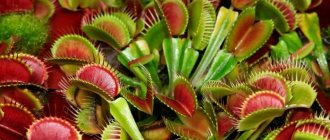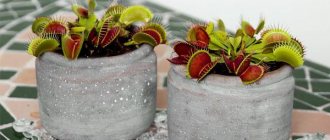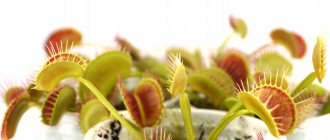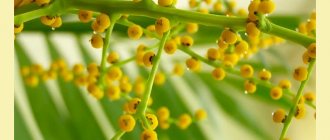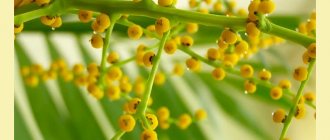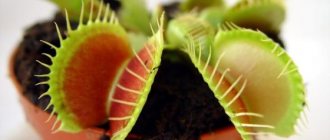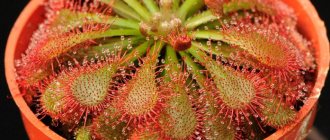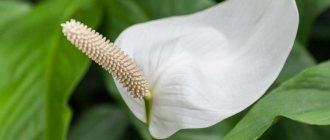How to grow a capricious Venus flytrap on a windowsill: what insects to feed it, how to water and care for it
Many people have heard about carnivorous plants. Some insectivorous plants can also be grown on your windowsill. The Venus flytrap feels great at home and even eats flies, spiders and other living creatures. True, she needs careful and special care. In this article, for those who decide to buy a Venus flytrap, we will try to tell everything about this plant.
Where does the house Venus flytrap grow in nature?
The Venus flytrap is a plant that can only be found on the North American continent, in the state of North Carolina. The flycatcher is listed in the Red Book, and the greatest danger to it is people who dig up the plant for the purpose of selling.
The predatory Venus flytrap is concentrated in one single area with a radius of only 150 kilometers in the vicinity of the city of Wilmington. This area has a temperate and humid climate, influenced by the nearby Atlantic Ocean with its warm currents .
The high mountains of the Appalachians also had a special influence on the fact that the carnivorous plant appeared here
. Their poor soils provoked the appearance of the insectivorous Venus flytrap, which obtains nutrients from ants, spiders and flies.
The Venus flytrap grows in poor soils low in nitrogen and other nutrients. Therefore, it has adapted to obtain the necessary chemical elements by eating insects.
Flycatcher caught prey
Signs about the Venus flytrap
The Venus flytrap is a windowsill predator, and is usually kept in the house to catch what it wants and catch luck by the tail. At the same time, the Venus flytrap is a symbol of love and femininity. Therefore, the signs associated with it are different.
- It is believed that if a Venus flytrap opened traps in the room where an unmarried girl lives, then the girl will soon have a groom. This flower is very tempting and dangerous for spiders and flies, and at the same time the flycatcher is gentle and capricious, like a real girl.
- If you want to attract a man to you, then you need to place a pot with a Venus flytrap in the room where you communicate. Then the man will definitely be yours. Perhaps this sign has real grounds. Firstly, Dionea exudes a subtle sweet aroma. Secondly, only an extraordinary girl who is guaranteed the attention of men can have such an interesting plant on her windowsill.
Venus flytrap helps girls find personal happiness
- The Venus flytrap is believed to be a plant that brings good luck in business. It helps you not to miss opportunities, be able to distinguish reliable business partners from unscrupulous people, and be in the right place at the right time.
- The Venus flytrap is considered the guardian of the house. She, like a predator, protects the house from people with evil thoughts. Such people will feel uncomfortable next to this plant and will try to leave your home as quickly as possible.
Among the beliefs about the Venus flytrap, there is not a single sign with a negative meaning. Although this plant is predatory and bloodthirsty towards insects, it has positive energy towards people.
Dionaea dormant period
In autumn, the plant prepares for a dormant period: the leaves dry out, turn black, and then fall off. The appearance of Dionaea is unpresentable, one might say, painful - inexperienced gardeners panic, trying to revive the plant with increased watering, warmth and bright lighting. But there is no reason to worry. The pot with the plant must be moved to a cool, dark place. The basement, bottom shelf of the refrigerator is perfect. The plant remains in this state until mid-February. Moisten the soil periodically. Active growth will begin by the end of spring.
House Venus flytrap structure life cycles
The Venus flytrap at home has from four to seven large leaves, on the tips of which traps grow. It is easier to buy an adult Venus flytrap in the warm season. In winter, the plant sheds all its leaves and goes into “sleep”.
During the cold season, the house Venus flytrap sometimes loses all its leaves, and the pot looks completely empty. Don't be alarmed and don't throw away the plant, it's still alive. Continue to care for the tuber in the ground and it is likely that it will delight you with new shoots.
Venus flytrap in a pot
The stem of the flytrap is buried in the ground, and the leaves are near the ground. This is how crawling insects more often crawl into the traps of a predatory plant.
The stem of the plant and its root system are closely located. If you dig up a house Venus flytrap from its pot, you will find a tuber and some fine roots. The structure of the plant resembles that of onions, beets, Jerusalem artichoke and other root vegetables. The Venus flytrap has a wide base and no overgrown roots.
Flytrap root
How does a flycatcher bloom?
Those who grow indoor plants are interested in how and when the Venus flytrap blooms.
Dionia blooms with small white flowers in late May early June. And its flowering is as amazing as the plant itself. A flowering Venus flytrap sends out a long stem on which flowers bloom. The carnivorous Dionia eats naive ants and flies, but “spares” the honey plants that pollinate it.
The inflorescence of the flycatcher is corymbose, similar to the inflorescence of phlox, with small white flowers. These flowers bloom from the buds sequentially: first some, and when the first ones fade, others. The formation of traps at the ends of leaves occurs after flowering.
Blooming Venus flytrap
It is believed that if the flycatcher is still very small, then it is better to cut off the stem thrown out for flowering. It drains a lot of strength and juice from the flytrap. The cut area must be treated with activated carbon, ground into powder.
After flowering, seeds remain on the shoots. Venus flytrap seeds are black and very small. They are hidden in many “boxes”.
Flycatcher seeds
If you look closely or use a magnifying glass, you can see that the seeds of the Venus flytrap are not round, but have a droplet-like shape.
Enlarged droplet-like shiny seeds
Vegetative propagation of Dionaea
Vegetative propagation of the Venus flytrap involves several options:
Rooting leaf cuttings
How to take cuttings from a Venus flytrap photo
Cut off part of the rosette (1-2 leaves), and treat it with a growth stimulator to improve the rooting process. You will need containers with a sand-peat mixture. Plant the cuttings, cover with a jar or cut-off plastic bottle on top, and provide bright, diffused lighting.
Dionaea from cuttings photo of young shoots
Ventilate periodically to prevent rot or mold. The process of complete rooting lasts about 3 months. Then plant the young bushes in separate pots with soil for adult plants.
Dividing the bush
How to divide a flycatcher bush photo
Dionaea forms lateral shoots (children) quite actively, but prefers to grow “in families”, since their frequent separation weakens the plant. It is optimal to carry out the procedure once every 3 years, combined with a transplant. Remove the plant from the pot and carefully divide it into several parts. It is better to use a scalpel or a very sharp knife; treat the cut areas with a fungicide. Place the delenki in separate pots.
Rooting the peduncle
Wait until the flowering stem reaches a length of 4-5 cm, then cut it and root it in peat, deepening it by 1 cm. Further actions are similar to rooting cuttings: creating a greenhouse effect, moistening the soil, lighting, ventilation. Over time, the peduncle will take on a lifeless appearance and may dry out almost completely, but this does not mean that the process is unsuccessful. Young shoots will appear after 1-2 months.
How to grow a Venus flytrap from seeds?
Two things need to be said right away. Firstly, growing a Venus flytrap from seeds is a long process, usually seedlings appear only after a month. Secondly, you need to be very careful when buying seeds from Chinese websites. Unscrupulous sellers sometimes pass off weed seeds as Venus flytrap seeds.
So, if you decide to buy a Venus flytrap in the form of seeds, then in addition to them you will need:
- Distilled water.
- Fungicide Topaz. A fungicide is a fungal control agent for plants. You can buy this product at a flower shop.
- You also need a piece of bandage, gauze, a cotton pad or any other material that is suitable for soaking seeds in it.
- You also need a container for planting and definitely a greenhouse. There should be no draft around the germinating seeds. A greenhouse can be made by covering the peas with glass or film.
Seed germination tactics may vary. If you grew the seeds yourself, you can literally plant them right away. Soak for just a few hours before planting.
It is believed that Venus flytrap seeds have the best germination rate when they are fresh. And it becomes lower literally after 3-4 days.
The first sprouts of a Venus flytrap
But what to do if you don’t have a Venus flytrap and you decide to order seeds by mail? In this case, it is recommended to soak the seeds for a long time before planting.
- Add 2 drops of Topaz fungicide to a glass of distilled water.
- Then a cloth is dipped into this solution and the seeds are wrapped in it.
- The package should be placed in a bag with small holes for ventilation.
- This bag should be placed in the refrigerator. So the Venus flytrap seeds should lie in the refrigerator for three weeks, the fabric should be periodically moistened so that it does not dry out.
- You need to plant a Venus flytrap by sprinkling the seeds onto the ground. There is no need to cover them with anything.
- Then the container with the seeds should be covered with glass or film and placed in a sunny place. In spring and summer, Venus flytrap seeds are germinated in a sunny place on a windowsill. In autumn and winter it is better to place them under a lamp.
Diseases and pests
The plant begins to suffer from fungus due to improper care - lack of light, excessive or insufficient watering. Its roots rot and mold forms on its leaves. If the valves cannot digest large prey, the trap is at risk of bacterial contamination and death. To prevent rotting of the entire plant from starting, the damaged valves are removed, and the entire flytrap is sprayed with a fungicide.
Yellowing of the leaves begins if you water the flower several times with tap water containing calcium salts.
Among the pests that can attack are aphids, spider mites and mealyworms - parasites common to the middle zone.
Venus flytrap - the process of eating insects
Venus flytraps have sensitive hairs inside their traps. If you touch only one of them, nothing will happen. But if you touch two hairs in succession, the trap will instantly slam shut.
The interval between touching two hairs can be up to 20 seconds. In this way, the Venus flytrap protects itself from false alarms. And it reacts precisely to insects that move their legs.
Charles Darwin himself called the Venus flytrap one of the most beautiful and amazing plants on our planet. The mechanisms of slamming its traps have not yet been fully studied.
It is believed that it is better to leave the Venus flytrap hungry than to overfeed it. Some gardeners say that the plant only needs 3-4 insects per month. Reference books even claim that a Venus flytrap needs 2-3 insects for a whole season.
Sensitive hairs inside the trap
The Venus flytrap carries out the process of closing the trap in just 100 milliseconds. For comparison, the average time it takes a person to blink is 400 milliseconds. Thus, by the time you blink, the Venus flytrap will have already caught the insect four times.
The Venus flytrap, like other carnivorous plants, lures insects with sweet nectar. It is sticky and found on the bright reddish surface of the trap leaves. The Venus flytrap also exudes an aroma that is not perceptible to humans, but is tempting to insects.
The Venus flytrap completes the digestion process of the insect in 2 weeks. After this, the trap opens again and is ready to meet a new victim.
The Venus flytrap takes 2 weeks to digest its prey.
If you value your pet Venus flytrap, don't slam its traps for fun. One trap can digest seven insects. After that it wears out. “Idle” slamming also harms the plant and weakens its leaves.
Charles Darwin was so fascinated by the Venus flytrap that he dedicated an entire book to it and other plants called “Insectivorous Plants.” In this book, the scientist described the taste preferences of the Venus flytrap.
- Ants make up 30 percent of the Venus flytrap's diet.
- Another 30 percent of the plant's food comes from spiders.
- 10 percent of the plant’s “menu” each comes from beetles and grasshoppers.
- Flies and other flying insects make up only 5 percent of the plant's diet in the wild.
Sometimes the Venus flytrap also eats slugs and snails. There is evidence that there have even been cases of Venus flytraps swallowing small frogs. However, the Venus flytrap at home does not need too large food. The insect should be no larger than a third of the size of the trap. Otherwise, the leaf may not cope and begin to rot.
Venus flytrap eats spiders
Venus flytrap at home: care and watering
The Venus flytrap is a very finicky plant at home. And there is a whole list of conditions that must be observed in order for the plant to develop normally.
Soil for the Venus flytrap
The Venus flytrap is very picky about the soil. She definitely needs acidic peat soil with an acidity level of 3 to 4.5. It is important that the soil is poor, without fertilizers. Sometimes peat soil for a Venus flytrap is mixed with perlite in a two to one ratio. Perlite is an artificial and completely neutral filler. It simply helps to better retain moisture, retain heat and prevent the formation of crusts in the plant pot.
The Venus flytrap can be damaged by any foreign matter in the pot. There is no need to put moss in the pot or plant other plants next to the Venus flytrap. Even the seeds of other plants that accidentally fell into its pot and began to decompose can destroy a delicate flytrap.
The most scrupulous owners even disinfect the soil before planting a Venus flytrap. The soil is dried in the oven or disinfected in the microwave.
Venus flytrap is small and delicate
Watering the plant
- The Venus flytrap should not be watered with tap water at home. The plant will simply die from this. Water the Venus flytrap with distilled water. Some housewives who find it difficult to buy distilled water manage to water the plant by exposing it to the rain.
- You can’t also water the Venus flytrap with a cup or watering can, as we are used to. This finicky plant can only be watered from a tray. That is, you need to pour water into a bowl, and then put the pot in this bowl.
- You can’t constantly keep the plant in a pan of water, but you also shouldn’t let the soil dry out. The soil in the pot should remain slightly moist. In winter, the flycatcher needs less water than in summer.
Watering a Venus flytrap from a tray
Spraying Venus flytrap
The Venus flytrap is a plant that loves moisture. Spray it regularly with a spray bottle. The flycatcher does not tolerate dry and hot air in winter. Therefore, it is advisable to take it out for the winter on a balcony or loggia, where the temperature is not higher than 10 degrees, but not lower than zero.
Venus flytrap and sunlight
The Venus flytrap needs direct sunlight. This plant is very light-loving. And it feels good only if it stands on a window that faces south. As a last resort, Venus flytraps are placed on windows facing east. In summer, it is advisable to take pots with flycatchers to balconies and loggias, where there is a lot of light.
Direct sunlight is beneficial for the Venus flytrap
Plant propagation and transplantation
The encyclopedia of indoor plants recommends replanting the Venus flytrap once every 1-2 years. This should be done in late spring or early summer.
The plant can reproduce by seeds and budding. To budding, you need to carefully remove the bulbs growing together from the ground and separate them. But you shouldn't do this too often. The fact is that plants do better when they grow in groups.
Sowing technology
It is recommended to sow the seeds after February 15 in order to transplant the seedlings into separate pots with the onset of summer.
The sowing procedure is performed according to the following algorithm:
- sow the seeds on the surface of the soil without deepening them; you can sprinkle them with moss;
- water with a spray bottle carefully so as not to brush them off the surface;
- cover the pots with plastic wrap;
- maintain the temperature background at 24-28 degrees Celsius;
- illuminate the crops at least 15 hours a day;
- Do not allow the soil to dry out when watering.
Important! If all the points on the list are followed, the seedlings will appear in 2 or 3 weeks. The film is removed at this time.
VIDEO: How to take care of a Venus flytrap?
Our website has many other interesting articles about growing indoor plants:
- Why don't violets want to bloom?
- Mother-in-law's tongue. How to properly care for this plant.
- Energy of indoor plants.
- Caring for cacti.
- Spathiphyllum flower or “female happiness”, signs about the plant and caring for it.
- Orchid on the windowsill.
